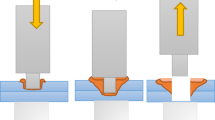Abstract
The application of friction stir welding (FSW) is growing owing to the omission of difficulties in traditional welding processes. In the current investigation, artificial neural network (ANN) technique was employed to predict the microhardness of AA6061 friction stir welded plates. Specimens were welded employing triangular and tapered cylindrical pins. The effects of thread and conical shoulder of each pin profile on the microhardness of welded zone were studied using tow ANNs through the different distances from weld centerline. It is observed that using conical shoulder tools enhances the quality of welded area. Besides, in both pin profiles threaded pins and conical shoulders increase yield strength and ultimate tensile strength. Mean absolute percentage error (MAPE) for train and test data sets did not exceed 5.4% and 7.48%, respectively. Considering the accurate results and acceptable errors in the models’ responses, the ANN method can be used to economize material and time.
Similar content being viewed by others
References
NAGESWARA RAO P, JAYAGANTHAN R. Effects of warm rolling and ageing after cryogenic rolling on mechanical properties and microstructure of Al 6061 alloy [J]. Materials & Design, 2012, 39: 226–233.
DAS H, CHAKRABORTY D, PAL T K. High-cycle fatigue behavior of friction stir butt welded 6061 aluminium alloy [J]. Transactions of Nonferrous Metals Society of China, 2014, 24(3): 648–656.
RAJAKUMAR S, MURALIDHARAN C, BALASUBRAMANIAN V. Statistical analysis to predict grain size and hardness of the weld nugget of friction-stir-welded AA6061-Tn 6 aluminium alloy joints [J]. International Journal of Advanced Manufacturing Technology, 2011, 57(1/2/3/4): 151–165.
PENG D, SHEN J, TANG Q, WU C, ZHOU Y. Effects of aging treatment and heat input on the microstructures and mechanical properties of TIG-welded 6061-T6 alloy joints [J]. International Journal of Minerals, Metallurgy, and Materials, 2013, 20(3): 259–265.
OKUYUCU H, KURT A, ARCAKLIOGLU E. Artificial neural network application to the friction stir welding of aluminum plates [J]. Materials & Design, 2007, 28(1): 78–84.
MISHRA R S, MA Z Y. Friction stir welding and processing [J]. Materials Science and Engineering R: Reports, 2005, 50(1/2): 1–78.
ÇAM G, MISTIKOGLU S. Recent developments in friction stir welding of Al-alloys [J]. Journal of Materials Engineering and Performance, 2014, 23(6): 1936–1953.
TOPIC I, HÖPPEL H W, GÖKEN M. Friction stir welding of accumulative roll-bonded commercial-purity aluminium AA1050 and aluminium alloy AA6016 [J]. Materials Science and Engineering: A, 2009, 503(1): 163–166.
SUN Y, FUJII H, TAKADA Y, TSUJI N, NAKATA K, NOGI K. Effect of initial grain size on the joint properties of friction stir welded aluminum [J]. Materials Science and Engineering: A, 2009, 527(1): 317–321.
UEMATSU Y, TOKAJI K, SHIBATA H, TOZAKI Y, OHMUNE T. Fatigue behaviour of friction stir welds without neither welding flash nor flaw in several aluminium alloys [J]. International Journal of Fatigue, 2009, 31(10): 1443–1453.
LIU H J, ZHANG H J, YU L. Effect of welding speed on microstructures and mechanical properties of underwater friction stir welded 2219 aluminum alloy [J]. Materials & Design, 2011, 32(3): 1548–1553.
BUFFA G, FRATINI L, MICARI F. Mechanical and microstructural properties prediction by artificial neural networks in FSW processes of dual phase titanium alloys [J]. Journal of Manufacturing Processes, The Society of Manufacturing Engineers, 2012, 14(3): 289–296.
MISHRA R S, DE P S, KUMAR N. Friction stir processing [M]. New York: Springer, 2014.
SHOJAEEFARD M H, BEHNAGH R A, AKBARI M, BESHARATI GIVI M K, FARHANI F. Modelling and Pareto optimization of mechanical properties of friction stir welded AA7075/AA5083 butt joints using neural network and particle swarm algorithm [J]. Materials & Design, 2013, 44: 190–198.
SHOJAEEFARD M H, AKBARI M, ASADI P. Multi objective optimization of friction stir welding parameters using FEM and neural network [J]. International Journal of Precision Engineering and Manufacturing, 2014, 15(11): 2351–2356.
GHETIYA N D, PATEL K M. Prediction of tensile strength in friction stir welded aluminium alloy using artificial neural network [J]. Procedia Technology, 2014, 14: 274–281.
PALANIVEL R, MATHEWS P K. Prediction and optimization of process parameter of friction stir welded AA5083-H111 aluminum alloy using response surface methodology [J]. Journal of Central South university, 2012, 19(1): 1–8.
MOOSABEIKI V, AZIMI G, GHAYOOR M. Influences of tool pin profile and tool shoulder curvature on the formation of friction stir welding zone in AA6061 aluminum alloy [J]. Advanced Materials Research, 2012, 445: 789–794.
RAFIQ M, BUGMANN G, EASTERBROOK D. Neural network design for engineering applications [J]. Computers & Structures, 2001, 79(17): 1541–1552.
HAYKIN S S. Neural networks and learning machines [M]. Pearson Education Upper Saddle River, 2009: 3.
COLEGROVE P, SHERCLIFF H R. 3-dimensional CFD modelling of flow round a threaded friction stir welding tool profile [J]. Journal of Materials Processing Technology, 2005, 169(2): 320–327.
CHOWDHURY S M, CHEN D L, BHOLE S D, CAO X. Tensile properties of a friction stir welded magnesium alloy: Effect of pin tool thread orientation and weld pitch [J]. Materials Science and Engineering A, 2010, 527(21/22): 6064–6075.
VENKATESHA B N, BHAGYASHEKAR M S. Preliminary studies on mecahnical and metallurgical behaviour of friction stir welded butt joints [J]. Procedia Engineering, 2014, 97: 847–853.
LIENERT T J, STELLWAG Jr W L, GRIMMETT B B, WARKE R W. Friction stir welding studies on mild steel [J]. WELDING JOURNAL-NEW YORK-, 2003, 82(1): 1–S.
SUTTON M A, REYNOLDS A P, YANG B, TAYLOR R. Mixed mode I/II fracture of 2024-T3 friction stir welds [J]. Engineering Fracture Mechanics, 2003, 70(15): 2215–2234.
LOHWASSER D, CHEN Z. Friction stir welding: From basics to applications [M]. Elsevier, 2009.
MILES M P, NELSON T W, STEEL R, OLSEN E, GALLAGHER M. Effect of friction stir welding conditions on properties and microstructures of high strength automotive steel [J]. Science and Technology of Welding & Joining, 2009, 14(3): 228–232.
Author information
Authors and Affiliations
Corresponding author
Rights and permissions
About this article
Cite this article
Dehabadi, V.M., Ghorbanpour, S. & Azimi, G. Application of artificial neural network to predict Vickers microhardness of AA6061 friction stir welded sheets. J. Cent. South Univ. 23, 2146–2155 (2016). https://doi.org/10.1007/s11771-016-3271-1
Received:
Accepted:
Published:
Issue Date:
DOI: https://doi.org/10.1007/s11771-016-3271-1




